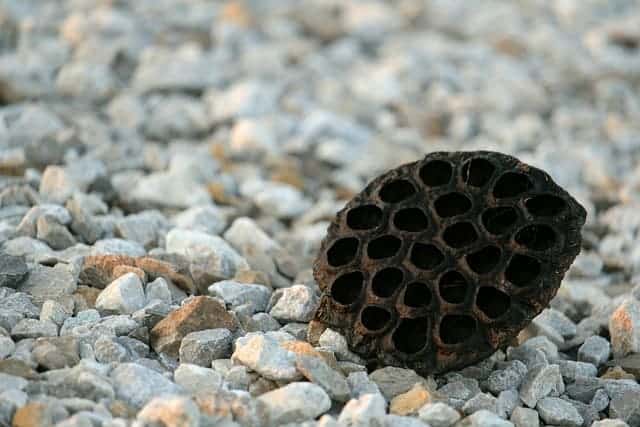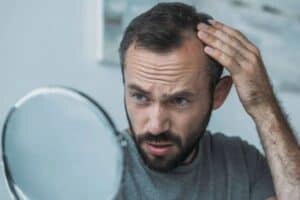Contents
- 1 How To Overcome Your Phobia in Time for Your Hair Transplant holes!
- 2 What is Hair Transplant Trypophobia and Why May it Affect Me?
- 3 Hair Transplant Holes: Analysing the Methodology of Hair Restoration surgery
- 3.1 Does Every Hair Transplant Procedure Trigger Trypophobia?
- 3.2 What Hair Transplant Method is Method is Best for Patients with Trypophobia?
- 3.3 So, Why is There A Stigma Around Hair Transplant Trypophobia?
- 3.4 What Should I Do If I Feel Uncomfortable About my Hair Transplant Holes During the Procedure?
- 3.5 Book Your Free Consultation
How To Overcome Your Phobia in Time for Your Hair Transplant holes!
Did you know that the NHS estimates over 10 million people in the UK to have a phobia? One of the most prevalent phobias affecting people of all ages is “Trypophobia”, an anxiety disorder that conjures feelings of fear and disgust to holes and small circular patterns. As an FUE hair transplant leaves tiny holes/scabs on your scalp shortly after surgery, here are some of the things you can do to treat your hair transplant Trypophobia. No one should be denied the opportunity for a hair transplant!
What is Hair Transplant Trypophobia and Why May it Affect Me?
Simply put, Trypophobia is an irrational fear of small clusters of holes in nature, on digital screens, and in everyday life. In Trypophobic patients, seeing holes causes feelings of irrational fear, hatred, and disgust.
Trypophobia may also cause sufferers to exhibit physical responses. In a clinical study conducted by Can et. al (2017), researchers noted nausea, itching, sweating, shaking, and even panic attacks to be common symptoms.
Typically, Trypophobia is treated by medical professionals, such as clinical psychologists and therapists. The most common treatments for phobias are exposure therapy, flooding, and cognitive behavioural therapy.
During these sessions, patients are taught management techniques to deal with, and ultimately overcome their feelings of anxiety.
If you’re looking for a healthcare professional to help treat anxiety caused by phobias, have a look on the NHS website. This is a great place to begin your recovery journey!
Are There Any Examples of Trypophobia?
Yes. However, for those with trypophobia, please be warned.



Hair Transplant Trypophobia
Hair Transplant Trypophobia is where a Trypophobic patient may develop an anxiety-induced response to their hair transplant holes. As with any other form of patterned holes, a hair transplant can cause a Trypophobic response.
Typically this condition is set off by seeing the open wounds left by large punches taken from the donor area (sometimes called the donor site).
Seriously, hair transplant trypophobia is no joke! It can cause serious psychological unrest in some patients.
What Can I Do To Treat My Trypophobia Before My Hair Transplant?
If you’re worried about hair transplant trypophobia, then you’re not alone. Hundreds of patients have come to our clinics wanting a hair transplant, informing us about their Trypophobia. Let us assure you, you’re in safe hands!
First thing’s first, in the lead up to your surgery it may be wise to book yourself some therapy sessions with a clinical psychologist or therapist, so you can work through your symptoms of anxiety before the big day.
If you’re taking any beta blockers or anti-anxiety medication, it’s probably wise to also take this on the day. However, run this by one of our consultants during your free consultation, as any medication changing blood pressure could affect your eligibility for a hair transplant.
Next, don’t do anything you’re not comfortable doing on the day of your surgery. Should you begin to feel stressed during the procedure, simply tell the doctor and he can help reduce your symptoms of anxiety.
If you wish, you can even bring a close relative on the day of your surgery. If they’re going to help your hair transplant trypophobia, then it’s fine by us!
Hair Transplant Holes: Analysing the Methodology of Hair Restoration surgery
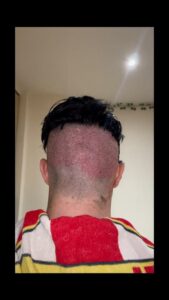 Hair transplants are quickly becoming one of the most popular medical procedures that people invest in to improve their appearance. In Europe alone, it is estimated that between 110,000 and 115,000 get a hair transplant every year, with this number being expected to rise even further!
Hair transplants are quickly becoming one of the most popular medical procedures that people invest in to improve their appearance. In Europe alone, it is estimated that between 110,000 and 115,000 get a hair transplant every year, with this number being expected to rise even further!
If you’re asking what a hair transplant is designed to treat, the answer is simple. A hair transplant looks to treat symptoms of permanent hair loss by using your own hair follicles as a treatment. A hair transplant will never use anybody else’s hair, only your own.
Whilst many people have tried other remedies to treat their hair loss, using chemicals such as minoxidil and finasteride, the only long term solution is to get a hair transplant. So, if you’re looking to end your hair loss concerns for good, the only genuine option is a hair transplant.
During a hair transplant procedure, a surgeon will extract your donor hair follicles from a donor site (in men, this is taken from the back and sides of the head). These donor hairs are then implanted one by one into your recipient area (in men, this is usually in the temple and crown area of the head).
As your hair follicles are extracted and implanted individually, this requires your hair transplant surgeon to use a micro punch device. The micro punch device implants each hair follicle into your recipient area. This process is repeated thousands of times, until you reach an adequate hair density.
More than 50% of all FUE hair transplants are conducted using a hole punch tool between 0.81-0.9mm. A staggering 99.4% of hair transplants ar conduce during a punch tool of 1mm or less. So, you’re highly unlikely to see any hair transplant holes!
During the implantation phase, tiny holes (less than 1mm in diameter) can punched so the new hair follicle fits seamlessly into your recipient area. This process is repeated thousands of times, until you reach an adequate hair density.
These small holes are what can cause reactions in patients with severe. In the first 10 days after your hair transplant surgery, you will see some visible scars in your recipient site. It will take the form of tiny scabs. Of course, this is caused by the small punch incisions.
After your surgery, you’ll be left with healthy hair follicles and transplanted hair that is highly resistant to the hormones that hormones that cause permanent hair loss. S0, there’s no need to worry about Telogen Effluvium or your Male Pattern Baldness.
Does Every Hair Transplant Procedure Trigger Trypophobia?
No! Unless you suffer with a severe case of trypophobia, you’re unlikely to be affected by any of the hair transplants we offer at Harley Street Hair Transplant Clinics. The hair transplantation services we offer are:
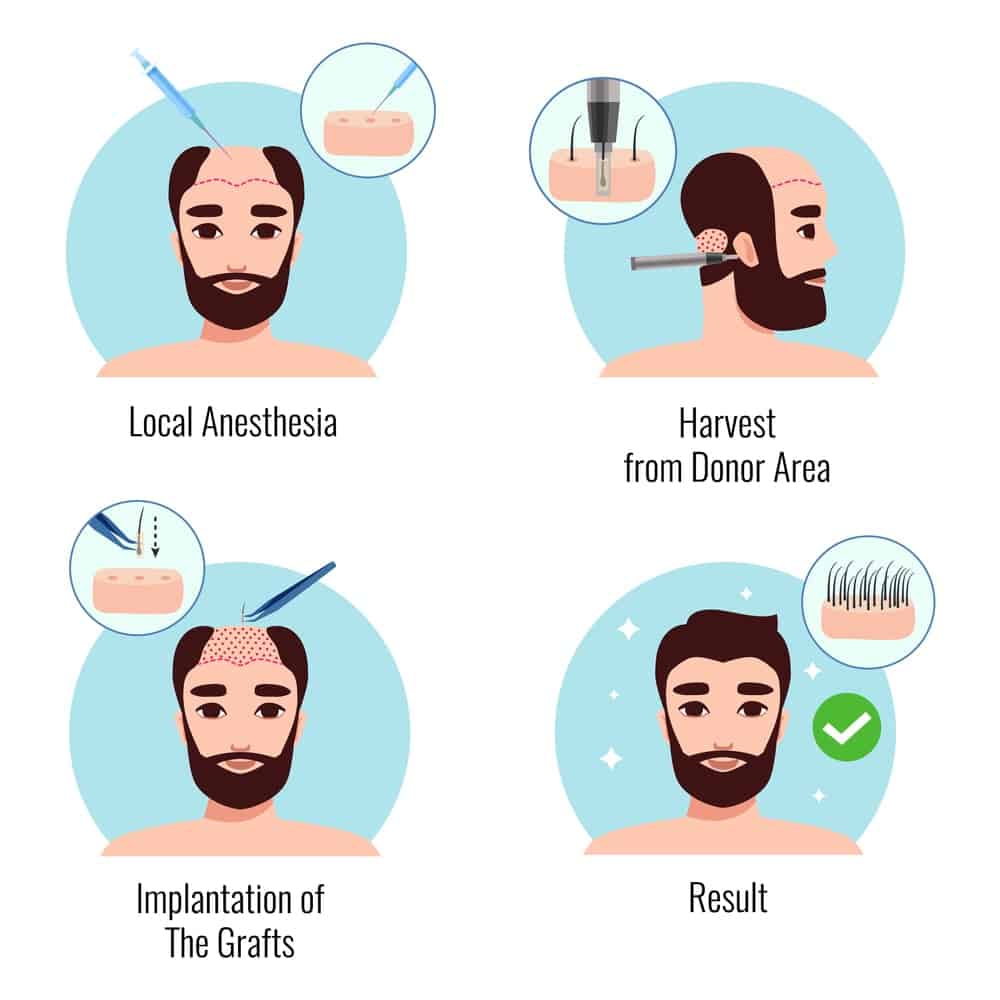
Follicular Unit Extraction (FUE) – this hair transplant method is, by far and away, the most popular hair restoration surgery on the market today. Whilst this may trigger trypophobia, it is important to consider that this method is minimally invasive, suitable for all hair types, has a quick recovery process (when compared to FUT), and is suitable for light to severe cases of balding.
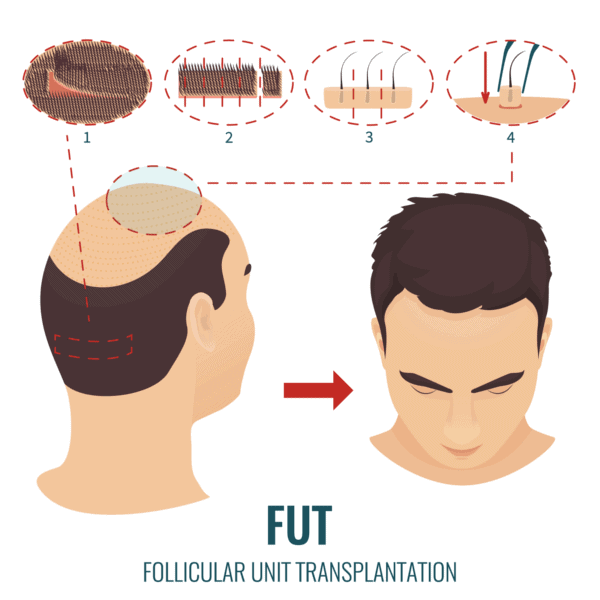
Follicular unit Transplantation (FUT) – nowadays, FUT is only used as a final resort for the most severe cases of balding. As this is one of the older methods of hair transplant surgery, it excises a strip of long skin from the scalp, leaving a lifelong scar on patients. So, if you are trypophobic, this is almost certainly not the hair transplant surgery for you.
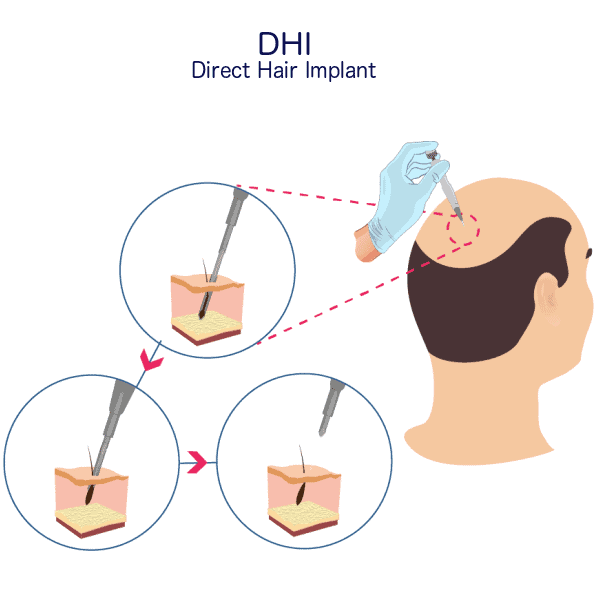
Direct Hair Implantation (DHI) – similar to FUE, DHI is the latest hair transplant method used by surgeons to combat hair thinning and hair loss. It uses a special implanter tool called the CHOI implanter pen to extract and implant follicles directly from the donor area into the area of hair loss. This method boasts the quickest recovery time of all hair transplant methods, making it ideal for patients with trypophobia.
What Hair Transplant Method is Method is Best for Patients with Trypophobia?
Our aim is to minimise the amount of phobia reaction for our hair transplant patients. As such, the aim is to choose a hair transplant process that will produce the smallest size scabs and boast the quickest recovery time for our patients.
But why? with smaller hair transplant holes, you’ll be less likely to see any post-procedure scabs, for a shorter period of time. So, this means you’re going to be less likely to feel anxious and this will occur for a shorter about of time.
For patients with trypophobia, we recommend a DHI, or FUE, hair transplant. As only small holes are created (even tinier in the case of DHI), with these two methods, this is going to minimise your recovery time.
For the first 5 days, post-surgery, you’re likely to have your head wrapped in clean bandages, meaning it’s going to be highly unlikely that you see your hair transplant holes anyway. But on the off chance, FUR or DHI is definitely the way to go!
So, Why is There A Stigma Around Hair Transplant Trypophobia?
It’s hard to say! The most likely reason behind hair transplant Trypophobia probably lies around surgeries that are conducted by clinics with poor reputations and those that do not use modern techniques to conduct a hair transplantation.
Larger, Trypophobia-inducing hair transplant holes are not only symptomatic of outdated and obsolete methods, but they are probably conducted in unhygienic clinics that are not medically certified. This may worsen the reputation of hair transplantation even further.
At Harley Street Hair Transplant Clinics, all of our procedures are carried out by GMC registered surgeons in CQC registered clinics. All of our hair transplants are carried out using punch tools with a diameter of 1mm or less, meaning you can rest assured that you’re in safe hands.
We’re dedicated to helping you overcome hair transplant trypophobia!
What Should I Do If I Feel Uncomfortable About my Hair Transplant Holes During the Procedure?
If you’re seriously concerned about hair transplant holes, then the first thing we’d suggest is to look at our before and after results. Although your Trypophobia may make you uncomfortable in the short term, it’s important to think about how your new hair is going to look one year on.
With no scabs, and a beautiful, thick hairline, you’ll wonder what all the fuss is about! Have a look at some of our before and after pictures here:
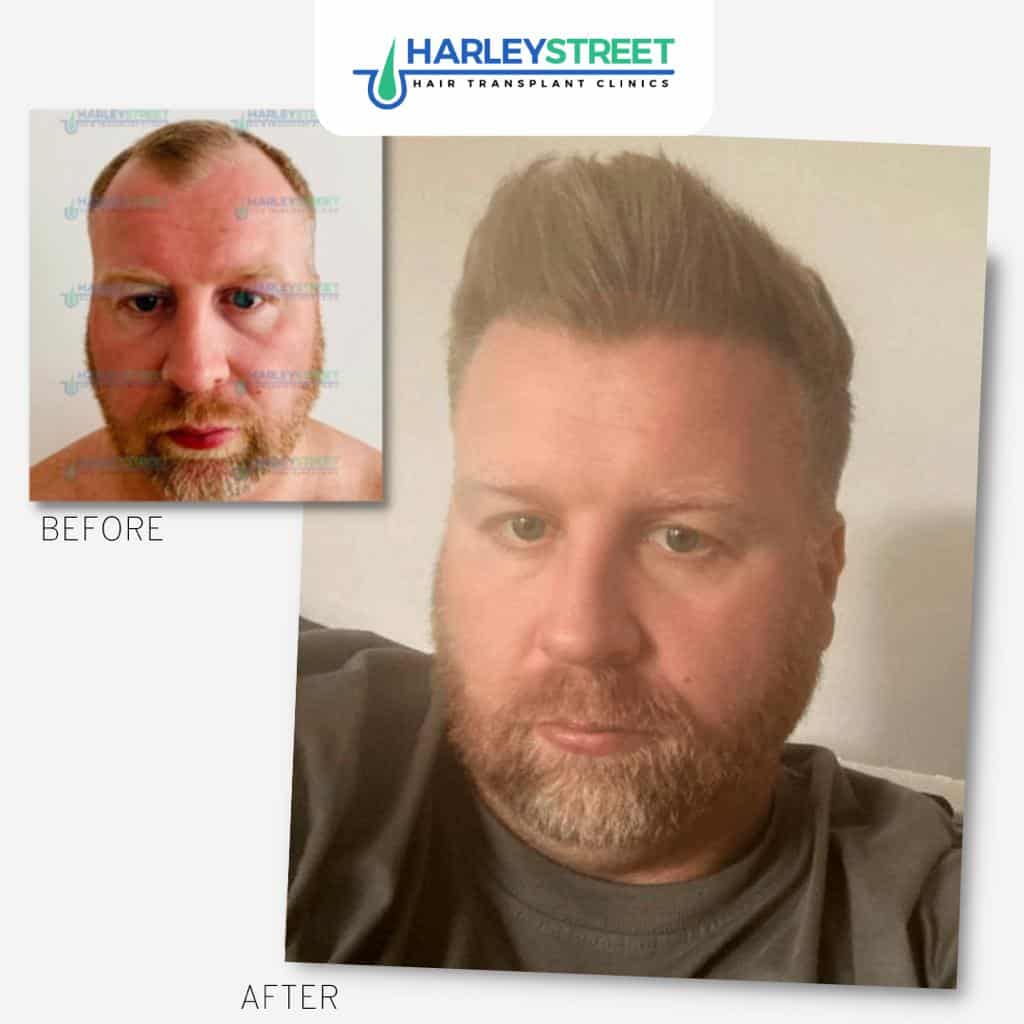
As you can see in this picture, there is no sign of any holes caused by the hair transplant. Within 10-14 days, the scabs will have healed fully, leaving your hair restoration to truly begin.
If you’re still feeling uncomfortable, we’re happy to put you in contact with our experienced surgeon, or one of our hair transplant consultants. Don’t hesitate to contact us. We’re happy to help!
Book Your Free Consultation
The final thing to do is to book your free consultation! At Harley Street Hair Transplant Clinics, we’re happy to walk you through your procedure, your concerns about hair transplant trypophobia, and your individually tailored aftercare plan. So, what’s stopping you?






